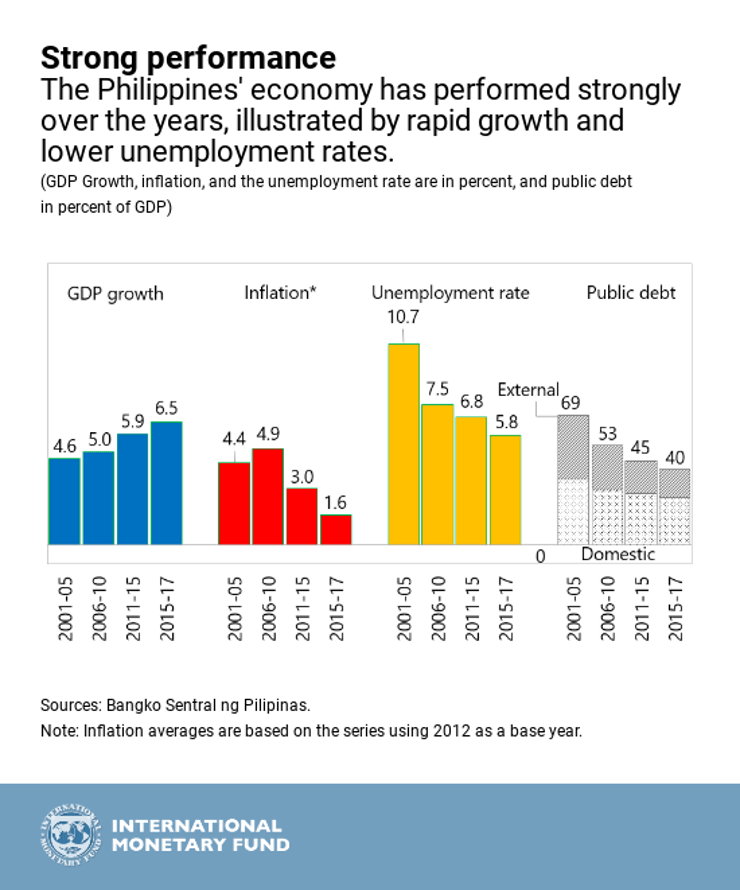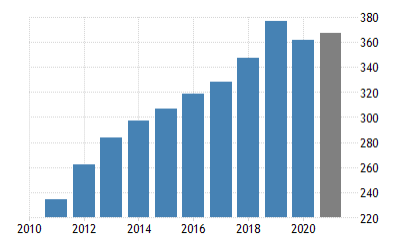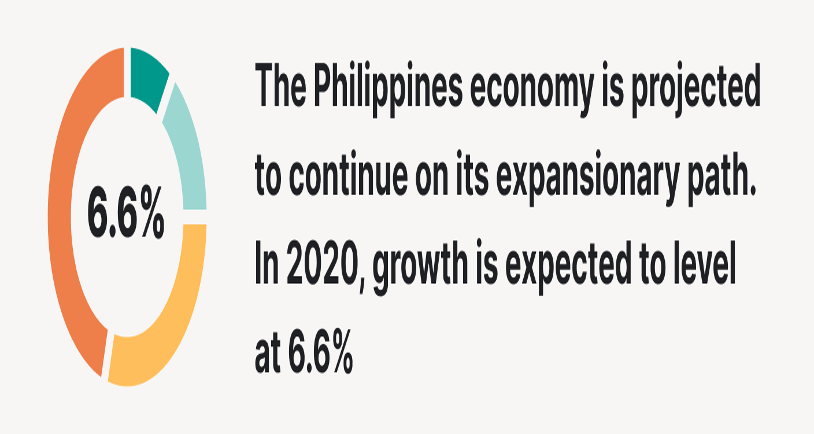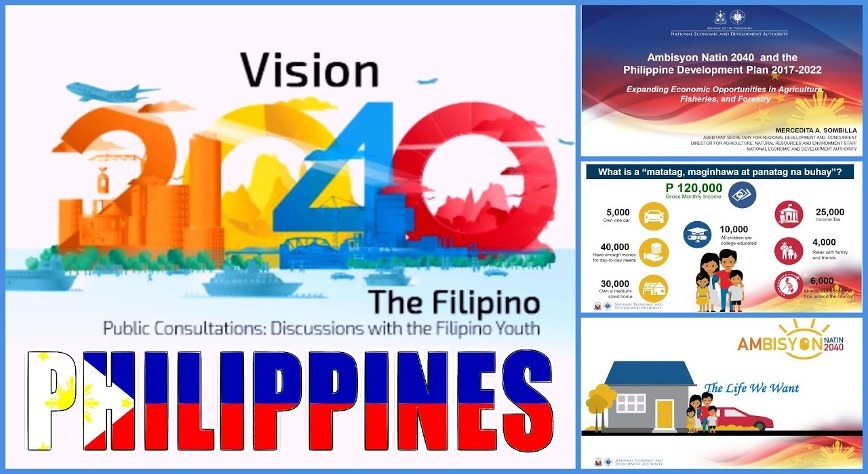
Dr. Mehmood Ul Hassan Khan has specialties in management, marketing, economics and governance. He has also master degree in Development with specialization in Diplomacy and Public Relations. He has also a rich experience in research, peace and conflict resolution and defence issues. His research and comprehensive articles have already been published in China, Uzbekistan, Iran, Turkey, Azerbaijan, USA, South Korea, UAE and Kuwait too.
He has great experience in the socio-economic, geo-politics and geo-strategic issues of Central Asia, Caucasus and Middle East. He is a famous expert on CIS and Caucasus in Pakistan. Member Board of Experts: CGSS, Islamabad. Ambassador at large at IHRFW.
The Philippines’ macro-economy has been growing over 6 percent since 2010. It is one of the “top performers” in the East Asia Pacific region. Its impressive economic performance is based on services, export led growth and remittances.
Its economic “boom” is reflected in the towering skylines, luxurious hotels and huge shopping malls. Its financial centers have become hot destination for regional as well as international investments.

Future Outlook
With increasing urbanization, a growing middle class, and a large and young population, the Philippines’ economic dynamism is rooted in strong consumer demand supported by a vibrant labor market and robust remittances. Business activities are strong and bright in the services sector including business process outsourcing, real estate, tourism, and finance and insurance industries.
Sound Economic Fundamentals
Its sound economic fundamentals, indicators and a globally recognized competitive workforce remain the growth engine. It has sustained average annual growth of 6.4 percent during 2010-2019 from an average of 4.5 percent during 2000-2009. Hopefully, it is on its way from a lower middle-income country with a gross national income per capita of US$3,850 in 2019-2020 to an upper middle-income country (per capita income range of US$4,046–$12,535) in the near term.
Impacts of COVID-19
Unfortunately, real economic growth somehow has been challenged by the COVID-19 pandemic and the strict community quarantine measures imposed in the country. Growth contracted significantly in 2020, driven by significant declines in consumption and investment growth, and exacerbated by the sharp slowdown in exports, tourism, and remittances.
According to many published reports of World Bank, IMF and ADB economic growth is expected to pick-up gradually in 2021-2022 assuming a containment of the virus domestically and globally, and with more robust domestic activity bolstered by greater consumer and business confidence and the public investment momentum.
Despite ongoing deadly COVID-19 crisis its economy has made progress in delivering inclusive growth, evidenced by a decline in poverty rates and its Gini coefficient.
Poverty Reduction
Poverty declined from 23.3 percent in 2015 to 16.6 percent in 2018 while the Gini coefficient declined from 44.9 to 42.7 over the same period. It was resultant of substantial increase in real wages, which is now expected to have a positive impact on household incomes. Resuming growth would also mitigate negative impact of poverty.
Burgeoning Middle Class
Another published report of the World Bank (2019-2020) forecasted that its burgeoning middle class is set to surpass the spending power of Italy’s middle class by 2030 which is a sign of the Southeast Asian nation’s growing economic might.

Growing Tech-Savvy Population
Its booming population has certain comparative advantage over its neighbours. It has a growing tech-savvy population, an exploding digital economy and an increasingly integrated regional trading network, all of which is helping to fuel the emergence of this new wealthy demographic and march towards formation of knowledge based smarter economy.
According to official statistics (2020-2021) digital penetration has reached well over half of the nation’s population with 67 million internet users and the same number of social media users. It shows its high level of ICT, and social connectivity through the help of virtual realities of social media which is indeed achieving miracles in rural community development, remote education, and health care. Its rapidly expanding digital culture has immensely developed online businesses both domestically and throughout the region.
Fastest Growing Economy 2019
According to World Bank (2020), the Philippines were one of the fastest growing economies in the world in 2019. Fortunately, it finally shunned its “sick man of Asia” reputation obtained during the economic collapse in the mid-1980s. After decades of constant structural reforms it managed to pay-off its debts incurred under the successive governments of the past. Resultantly, its economic renaissance was surfaced in the last decade prior to the pandemic during which it was considered as next Asian tiger economy.
Philippines’ Economic Model
Philippines’ economic model has been transformed and built around the mobility of people, tourism, services, and remittances-led growth. But due to lockdowns and consumer confidence decline its national economy suffered. Moreover, international travel plunged, tourism came to a grinding halt, and domestic lockdowns and mobility restrictions crippled the retail sector, restaurants, and hospitality industry. Fortunately, its business process outsourcing sector is offering resilience.

Pandemic poor handling and lockdown badly lessened consumer markets and reduced circulation or money. Credit mobilization and channelization of new loans remained docile in the country resultant strains on banking and financial systems, health test-trace-treat systems.
Functional Proposals
It is suggested that policy makers of Philippine should build a more efficient containment strategy particularly against the threat of possible new variants principally by strengthening the test-trace-treat system. They should try to strengthen the sufficiency and transparency of direct social protection in order to give immediate relief to poor and low-income households already severely impacted by the mishandling of the pandemic.
Moreover, ramp-up vaccination to cover at least 70 percent of the population should be achieved as soon as possible, and enlist the further support of the private sector and civil society in order to keep improving vaccine rollout is the need of the hour. They should also develop an integrative system to create a build-back-better strategy anchored on universal and inclusive healthcare.
The Asian Development Outlook (2021)
The Asian Development Outlook (2021) has forecasted the Philippine economy to increase by 4.5 percent in 2021 and 5.5 percent in 2022. Substantial progress in the country’s vaccination rollout will help restore consumer and business confidence, though uncertainties over how the pandemic will unfold globally and domestically can pose risks to growth prospects.
It suggested that priority should be given to addressing the scarring effects of the pandemic on private sector employment. In this way, befitting proposition and meaningful programs would support workers and firms affected by labor market adjustments and reforms to boost productivity growth and investment. It would definitely diminish the negative effects of the pandemic on employment over the medium term.
Right Expansionary Fiscal & Monetary Policies
It seems that its right expansionary fiscal program and supportive monetary policy will put the macro-economy on a firm recovery path by the second half of 2021. It says government plans to strengthen labor market programs and assist in the recovery of sectors badly affected by the pandemic, including agriculture and tourism, will further support a pickup in the economy.
Inflation is forecast to increase 4.1 percent in 2021, up from 2.6 percent in 2020, due to rising global commodity prices and other supply-side factors. However, inflation is expected to ease to 3.5 percent in 2022 as government takes measures to address supply-side pressures.
The current account surplus is forecast to narrow to 2.5percent of GDP in 2021 and 1.8 percent in 2022. Merchandise exports are expected to increase with the rise in global trade, as imports, especially capital goods, rebound to support public infrastructure development.
AmBisyon Natin (Vision 2040)

It represents the collective long-term vision and aspirations of the Philippine government and its people for the next 20 years. It is road map of socio-economic prosperity, massive industrialization, eradication of poverty, education, health and housing facilities and last but not least materialization of long awaited dreams of a qualitative life.
It upholds the picture of prosperity, progress and productivity. It is the ultimate destination of poverty free society. It is the vision that guides the future and is the anchor of the country’s plans.
It is the result of a long-term visioning process that initiated in 2015. More than 300 citizens participated in focus group discussions and close to 10,000 answered the national survey. Technical studies were prepared to identify strategic options for realizing the vision articulated by citizens. The exercise benefitted from the guidance of an Advisory Committee composed of government, private sector, academe, and civil society.
It is a government pledge to create a stable and comfortable lifestyle for its general masses till 2040. It is a noble promise of policy makers to secure the future of next generations by providing vast opportunities of education. It is a Grand National strategy for all the families to live a harmonious life with freedom, protection and provision of basic human rights last but not least institutionalization of elements of fair-play, transparency, accountability and checks and balances to achieve the optimal goals of good governance in the country.
The Vision 2040 has holistic policy to cater the basic needs of all segments of society and all sectors of economy whether public or private. It stimulates the government to use its tools of fiscal, monetary and regulatory policies to steer the development path towards enabling the people to achieve their long awaited dreams.
Hopefully, successful implementation and persuasions of Vision 2040, the Philippines will have a prosperous middle class society where no one will be poor. People will live long and healthy lives will be smarter and innovative.
Resultantly, the country will be a high-trust society where families will be thriving in vibrant, culturally diverse, and resilient communities.
It covers all aspects of economy i.e. Housing and Urban Development Construction (HUDC), development of manufacturing utilities (electricity, gas, and water), Food Processing Manufacturing (FPM) Transport Manufacturing System (TMS), infrastructural development (roads, bridges, ports, airports, vehicles etc.), education services, tourism and allied services, agriculture, food production, commercial and industrial crop, agricultural biotechnology, etc. health and wellness services, primary, secondary, and tertiary care, pharmaceuticals, wellness facilities, sports and fitness facilities, etc. and last but not least financial services, consumer financing, enterprise financing, and insurance savings mobilization.
The Vision 2040 ensures that economic growth should be broad-based across sectors and regions. It will facilitate a more equal income distribution. Moreover, there should be aggressive interventions to increase opportunities for the poor to participate in the growth process even as they are protected against the negative impact of economic and political instabilities, natural and man-made calamities. Poverty must be eradicated by 2040, if not earlier.
Pak-Philippine Bilateral Relations
Official bilateral relations between the two countries commenced with the establishment of the Philippine Consulate in Karachi on September 9, 1949, followed by the opening of the Philippine Embassy in Karachi in 1956 and Pakistani Embassy in Manila in September 1957. In 1954, both countries became alliance partners in the Southeast Asia Treaty Organization (SEATO).
The diplomatic ties of Pakistan and the Philippines are 74 years old. During this period both countries have enjoyed resilient ties of friendship regulated through more than 25 cooperation agreements/ MoUs in political, economic, commercial, defense, cultural and social fields. Ten new draft Agreements/ MoUs/ MoAs are currently under consideration of both countries so as to further expand the scope and strength of their relationship.
Right from the beginning, both countries agreed to reactivate the Pakistan-Philippines Joint Business Forum and Council with the participation of the Chamber of Commerce and Industry of the Philippines and the Federation of Pakistan Chamber of Commerce and Industry, the Department of Foreign Affairs (DFA).
The Philippine-Pakistan Business Council was established late 2003 and was launched in September 2004. It enhanced bilateral economic cooperation especially in the areas of trade, investment, energy, agriculture, tourism, health, industries and other matters of mutual interest.
Pakistan’s relations with the Philippines form an important component of our “Vision East Asia Policy” which aims at enhancing our collaboration with the region in diverse fields. The Philippines, a founding member of Association of South East Asian Nations (ASEAN), has been a staunch supporter of Pakistan’s efforts to strengthen institutional linkages with ASEAN and including membership to ASEAN Regional Forum (ARF) and Asia Europe Meeting (ASEM).
Both countries have been closely coordinating in promoting global interfaith dialogue. They share concerns for global equity, fair trading opportunities and welfare of overseas workers.
According to official statistics (2019-2020) the Philippines’ is currently Pakistan’s 43rd biggest partner while Pakistan is the Philippines’ 49th biggest partner. The bilateral trade between Pakistan and the Philippines stood at $ 172 million during 2017-8.
Furthermore, main exports from Pakistan during 2017 to 2018 included chemicals and compounds, rice, medical and pharmaceutical products, fruit and fruit preparations, made-up textiles, woven cotton fabric, medical and surgical instruments and appliances, knitted and crocheted clothes, cotton yarn, paper and paper board, tobacco, leather and leather products and cement.
Moreover, main imports from the Philippines during this period included automobile machinery parts, ores/ iron and steel and scrap, paper, cigarettes, transmission shafts, miscellaneous edible products, fruit and fruit preparations, , essential oils, chemicals and compounds, fixed vegetable fats and oils, old clothing and semi-conductors.
Bilateral Political Consultation (BPC) between two countries was held in Islamabad at Foreign Secretary level on January 18, 2018.The two sides reviewed the entire spectrum of bilateral relations and identified opportunities and possibilities for further cooperation including in the fields of security, counter-terrorism, economic development and trade, education, science and technology and agriculture. Both sides expressed satisfaction at their ongoing collaboration at the UN and other multilateral fora.
Pakistan-Philippines Joint Economic Commission (JEC) at Deputy Minister level was held in Islamabad on February 27 to 28, 2018. During two days of the JEC Session, detailed meetings were held between experts of the two sides focusing on Trade, Investment, Energy, Agriculture, Tourism, Health, Industries and other matters of mutual interest. An important decision of the meeting was to conduct feasibility studies on the possibility of Preferential Trade Agreement between the two countries.
Pakistan-Philippine Business Council Delegation visited Philippine during 2019 and explored untapped sectors to make investments and start joint ventures.
In this connection, state Visit of Pakistani President Pervez Musharraf to the Philippines during 2005 further strengthened bilateral relations between the two countries. Some important agreements were signed namely; a Memorandum of Understanding on Cooperation to Combat Terrorism and Certain Other Crimes; Visa Waiver Agreement for Diplomatic Passport Holders; Cultural Exchange Program for 2005-2009; and a Memorandum of Understanding between the Philippine Trading International Corporation (PITC) and the United Marketing on the Importation of Medicines from Pakistan. President Musharraf and President Arroyo agreed to cooperate against terrorism and to promote interfaith dialogue.
Both countries signed two economic agreements, namely the Philippines-Pakistan Trade Agreement and the Philippines-Pakistan Agreement for the Promotion and Reciprocal Protection of Investment, on 29 September 1961 and 23 April 1999 in Manila, respectively.
According to Pakistan’s official data (2020-2021) bilateral Trade in 2020 totaled US$ 154 million out of which Pakistan’s share in exports to the Philippines stood at US$ 120 million. There was a decrease of 10% in trade volume compared to 2019 figures, mainly due to COVID-19. The highest trade balance a decade earlier stood at US$ 74 million in 2011 which has more than doubled in the past few years.
Pakistan could share military equipment such as arms, ammunition, and drones with the Southeast Asian country to boost their alliance. Pakistan Aeronautical Complex in Kamra as a producer of warplanes such as the JF-17 Thunder, which could be shared with the Philippines.
In this regard, Philippine President Rodrigo Duterte expressed his country’s interest in expanding cooperation with Pakistan in the fight against terrorism.
Being prominent regional expert on ASEAN I suggest that Pakistan and Philippine should focus on people-to-people, business-to-business and cultural diplomacy for the further strengthening of bilateral relations in terms of economy, politics, production, connectivity, trade & commerce, joint ventures, FDIs, banking and finance, SMEs, Micro-financing, infrastructural development, food processing manufacturing, textiles, garments, ICT, digitalization, artificial intelligence technologies, education, sports and last but not least, electronics etc.
Its macro-economy is considered as one of the most dynamic economies in East Asia and the Pacific. Its salient features or economic drivers are solid fundamentals, a competitive workforce, a stable job market, steady remittances, and investment in the construction sector which needs to be replicated in Pakistan.
Comparative advantages of both the countries should be carefully studied to form a win-win situation for both the countries to foster trade and economic ties. In this regard, China Pakistan Economic Corridor (CPEC) may be a grand bench mark and economic stimulator to create strategic cushion for both the countries especially respective private sectors. Moreover, extended defence cooperation would bring both the countries closer.
Moreover, its miraculous economic growth model has been based on services, export led policies, mobility of the labour and worker remittances too. Dawn of ICT and digitalization has now transformed its outlook in the region. Philippine’s constant GDP of over 6 percent for the last decade vividly reflects the diversification of economy and integrative mechanism of smarter economy which should be replicated in Pakistan.
There is an urgent need to form a Corridor of Knowledge between the two countries especially among the different universities of both the countries. Cultural diplomacy would be a push-forward force to create better mutual understanding.
Philippine Vision 2040 is a strategic document. It is a road map to achieve socio-economic goals. It is an integrative mechanism to achieve desired goals of prosperity, progression, productivity, community development, eradication of poverty, giant step toward food manufacturing and economic self-reliance, social vibrancy, political stability, economic sustainability, good governance, transparency, accountability, social justice, provision of basic human rights and last but not least to materialize qualitative life.
To conclude, Philippine is an archipelagic country in Southeast Asia. It is situated in the western Pacific Ocean, and consists of about 7,640 islands, that are broadly categorized under three main geographical divisions from north to south: Luzon, Visayas, and Mindanao. Thus there is a huge scope for cooperation in the field of tourism between the countries.
Tourism is an important sector for Philippine economy. In 2019, the travel and tourism industry contributed 12.7 percent to the country’s GDP. Its colorful beaches, rich heritage towns and historic monuments, attractive mountains, confortable rainforests, beautiful islands and diving spots are among the country’s most popular tourist destinations.
Critical analysis of Philippine macro-economy reveals that a lack of domestic and foreign competition is the main constraint to boosting productivity growth, which is reflected in the country’s high market concentration, its low trade openness despite low tariff rates, low foreign direct investments in productive sectors, and low levels of innovation. It is suggested that Philippines needs to sustain an average annual total-factor productivity growth rate of 1.5 percent or higher in the next 22 years, more than double the world average since 2000. Thus role of private sector is immense.
Therefore, acceleration of capital accumulation in the medium term will be essential to reducing infrastructure and capital constraints to growth, which will require the implementation of important reforms.

